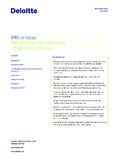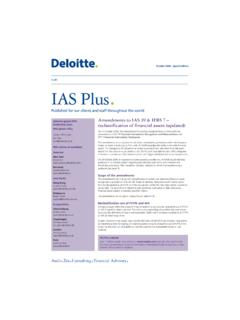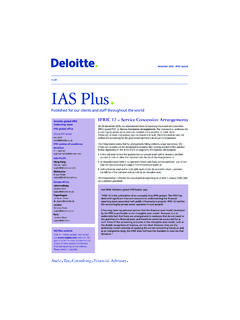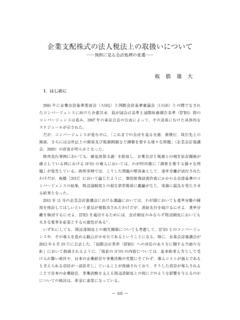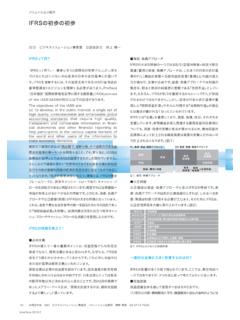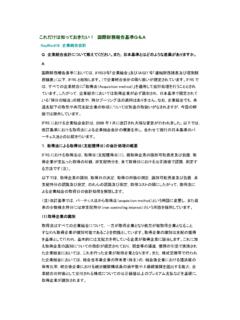Transcription of Business combinations and changes in ownership interests
1 Combinationsand changes inownership interestsA guide to the revisedIFRS 3 and IAS 2725263 bd ifrs3 IAS27:25263 ifrs3 /IAS27 bd 4/7/08 10:02 Page aContactsGlobal ifrs leadership teamIFRS global officeGlobal ifrs leaderKen centres of excellenceAmericasRobert PacificHong KongMelbourneStephen TaylorBruce Peter LarsenGraeme BerryVeronica PooleLaurence s provides comprehensive information about internationalfinancial reporting in general and IASB activities in particular. Unique features include: daily news about financial reporting globally. summaries of all Standards, Interpretations and proposals. many ifrs -related publications available for download. model ifrs financial statements and checklists. an electronic library of several hundred ifrs resources. all Deloitte Touche Tohmatsu comment letters to the IASB. links to several hundred international accounting websites. e-learning modules for each IAS and ifrs at no charge.
2 Complete history of adoption of IFRSs in Europe and information about adoptions of ifrs selsewhere around the world. updates on developments in national accounting bd ifrs3 IAS27:25263 ifrs3 /IAS27 bd 4/7/08 10:02 Page bContents1. of major of IFRSs and US GAAP32. Principles underlying the revised an accounting boundary involves a disposal63. Acquisition method of accounting94. of a Business outside the scope of ifrs 3(2008) of a joint control involving mutual entities145. Identifying a Business obtains control as a result of a transaction or an a of , processes and for a transaction that is not a Business combination206. Identifying the 27 guidance on and of voting purpose capital guidance in marginal to specific effected by creating a new entities317. Determining the acquisition of acquisition to the timing of the payment of securities transferred as guidance3325263 bd ifrs3 IAS27:25263 ifrs3 /IAS27 bd 4/7/08 10:02 Page c8.
3 Recognising and measuring the identifiable assets acquired, the liabilities assumed and any non-controlling interest in the for or designating identifiable assets acquired and liabilities assumed in a Business at the acquisition not at the acquisition principle for assets and with uncertain cash flows (valuation allowances) that the acquirer intends not to use or to use in a way that is different from the way other market participants would use interest in an of of choice between alternatives for measuring non-controlling the fair value of non-controlling measurement of non-controlling balances on non-controlling on specific assets and of identifiable intangible workforce and other items that are not to the recognition and measurement relationships and reacquired of reacquired rights as an intangible of gain or loss on settlement of a pre-existing payment held for measurement6525263 bd ifrs3 IAS27:25263 ifrs3 /IAS27 bd 4/7/08 10:02 Page d9.
4 Identifying and measuring at acquisition based on additional information aboutfacts and circumstances at the acquisition what is part of the Business combination to determine what is part of the Business of a pre-existing relationship between the acquirer and acquiree in a Business for contingent payments to employees or selling share-based payment awards exchanged for awards held by the acquiree s obliged to replace makes voluntary awards to consideration and post- combination transaction that reimburses the acquiree or its former owners for paying the acquirer s acquisition-related costs8310. Recognising and measuring goodwill or a gain from a bargain Measuring goodwill or a gain from a bargain Special Share-for-share Business combinations with no Mutual Consideration Basis of Identifiable net assets Bargain Accounting for a bargain purchase Reassessment required prior to recognising a bargain purchase gain8911.
5 Post- combination General guidance on subsequent measurement and Specific Adjustments to provisional Use of provisional The measurement What can be adjusted? Retrospective adjustments9225263 bd ifrs3 IAS27:25263 ifrs3 /IAS27 bd 4/7/08 10:02 Page Adjustments after the measurement Deferred tax arising from a Business combination9412. Step acquisitions and partial Control achieved in two or more Financial asset becomes an associate or a jointly controlled Transactions between parent and non-controlling Implications of the measurement basis of non-controlling Disposal of a controlling interest but retaining a non-controlling residual Adjustments on loss of Subsequent accounting for a residual Interaction with ifrs Disposal of an associate or a jointly controlled entity but retaining a financial Accounting in the investing entity (where separate financial statementsare prepared)10613.
6 Business combinations with no transfer of Accounting requirement and combinations by contract Example of a dual listed Accounting for a combination by Application of the acquisition method to a combination in which no consideration is Deemed Amount attributed to non-controlling interests10914. Reverse Identifying a reverse Meaning of reverse Acquiree must meet the definition of a More complex Accounting for a reverse Accounting Detailed accounting Presentation of equity and comparative Worked example of a reverse acquisition11615. Effective date and ifrs 3(2008) effective Mandatory Early Effect on a calendar-year Summary table for various reporting IAS 27(2008) effective date12225263 bd ifrs3 IAS27:25263 ifrs3 /IAS27 bd 4/7/08 10:02 Page General Entities previously outside the scope of ifrs Deferred tax assets arising in a Business Amendments to IAS 28 and IAS Amendments to other IFRSs12616.
7 Business combinations in the current period or after the reporting Details of the Business Fair value of consideration and details of contingent Details of acquired Details of assets acquired and liabilities Details of contingent liabilities Details of transactions recognised Details of bargain Details of non-controlling Business combinations achieved in Impact of acquiree on amounts reported in the statement ofcomprehensive Business combinations after the reporting Adjustments recognised for Business combinations that occurred in the current or previous reporting Business combinations for which the initial accounting is Contingent assets and contingent Material gains and losses recognised in the Additional disclosure requirements in IAS 27(2008) Disclosure of the impact of adoption of the new Standards and of accounting policies under the Discussion of revised Standards in advance of Discussion of impact of revised Standards in the period of Disclosure of accounting policies142 Appendix 1 Comparison of ifrs 3(2008) and ifrs 3(2004)146 Comparison of IAS 27(2008) and IAS 27(2003)150 Appendix 2 Continuing differences between IFRSs and US GAAP15125263 bd ifrs3 IAS27:25263 ifrs3 /IAS27 bd 4/7/08 10.
8 02 Page gAbbreviationsACAcquiring CompanyBCBasis for ConclusionsCEO Chief Executive OfficerFASBF inancial Accounting Standards Board (US)GAAPG enerally Accepted Accounting PrinciplesIASBI nternational Accounting Standards Board (the Board)IEIllustrative Examples (accompanying ifrs 3(2008))IFRICI nternational Financial Reporting Interpretations Committee of the IASB andinterpretations issued by that committeeIFRS(s)International Financial Reporting Standard(s)IGImplementation guidance (accompanying IAS 27(2008))NCINon-controlling interest(s)OCIO ther comprehensive incomeSFASS tatement of Financial Accounting Standards (US standards)SICS tanding Interpretations Committee of the IASC (predecessor body to the IASB) andinterpretations issued by that committeeTCTarget CompanyThroughout this guide, paragraphs that represent the authors interpretations and examplesother than those cited in IFRSs are highlighted by green bd ifrs3 IAS27:25263 ifrs3 /IAS27 bd 4/7/08 10:02 Page h1.
9 IntroductionIn January 2008, the International Accounting Standards Board (the IASB) issued a revised ifrs 3 Business Combinationsand a revised IAS 27 Consolidated and Separate Financial Statements,referred to in this guide as ifrs 3(2008) and IAS 27(2008) respectively. In doing so, the Boardcompleted phase II of its Business combinations project, and achieved substantial convergencebetween International Financial Reporting Standards (IFRSs) and US Generally Accepted AccountingPrinciples (US GAAP) on these guide deals mainly with accounting for Business combinations under ifrs 3(2008).Where appropriate, it deals with related requirements of IAS 27(2008) particularly as regards thedefinition of control, accounting for non-controlling interests , and changes in ownership aspects of IAS 27 (such as the requirements to prepare consolidated financial statements anddetailed procedures for consolidation) are not addressed. Summary of major changesFive headline changes brought about by the 2008 Standards are set out in the following table, andexplained in profit or lossAdjustments to liability recognisedin profit or lossChoice of measurement basis fornon-controlling interestsPrevious/residual holdingsremeasured to fair valueRecognised in equity nogoodwill or profit/lossAcquisition costsContingent considerationPartial acquisitionsStep acquisitionsTransactions with non-controllinginterests1 Introduction25263 bd ifrs3 IAS27:25263 ifrs3 /IAS27 bd 4/7/08 10:02 Page 1 Acquisition costsAll acquisition-related costs ( finder s fees, advisory, legal, accounting,valuation and other professional or consulting fees) are to be recognised as period expenses andgenerally written-off rather than added to goodwill (as previously).
10 Costs incurred to issue debtor equity securities will continue to be recognised in accordance with the Standards on financialinstruments. This change reflects the Board s move to focus on what is given to the vendor asconsideration, rather than on what is spent to achieve the acquisition. The change is explainedfurther in section Contingent considerationConsideration for an acquisition, including any contingentconsideration arrangements, is recognised and measured at fair value at the acquisition dateSubsequent changes in those fair values can only affect the measurement of goodwill wherethey occur during the measurement period and are as a result of additional informationbecoming available about facts and circumstances that existed at the acquisition date. All otherchanges ( due to the acquiree meeting an earnings target, reaching a specific share price,or meeting a milestone on a research and development project) are dealt with in accordancewith relevant IFRSs.


